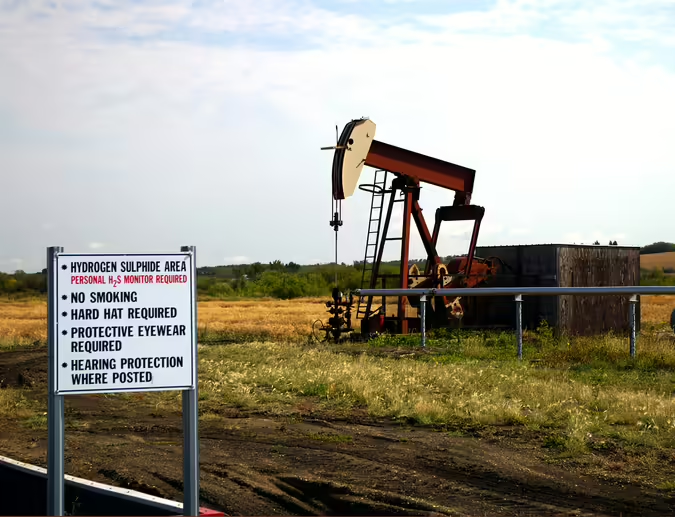
Hydrogen sulfide gas (H2S) is a well-known oilfield hazard.
But a recent report suggests the highly toxic, fast-killing vapors aren’t just a threat to the men and women employed on drill sites across Texas; they’re also seeping into communities, near families, schools, and businesses.
To make matters even worse, Texas regulators are doing little to address the problem.
Understanding the Dangers of H2S Gas
Heavier than air, colorless, and recognizable by its distinct “rotten eggs” odor, H2S gas is a leading cause of sudden death in the workplace. Concentrations greater than 500 ppm will render an individual unconscious, while a single breath at 1,000 ppm results in immediate loss of consciousness, cardiac arrest, and death.
Individuals who come into contact with low levels of H2S for a prolonged period will eventually lose the ability to pick up its scent. However, among those exposed to higher concentrations, the inability to smell H2S gas occurs instantaneously, leaving them completely unaware of the potential danger.
According to data compiled by the U.S. Occupational Safety & Health Administration (OSHA), hydrogen sulfide poisoning killed nine workers across all sectors in 2019 and five in 2020, including several in the oilfield industry. H2S gas was also implicated in four workplace fatalities in 2022, including the tragic deaths of an oilfield worker and his wife on the northwest side of Odessa, Texas.
There were 60 fatalities related to H2S gas reported among U.S. oil and gas workers between 2012 and 2022. During that period, H2S poisoning also ranked as the leading cause of death in the industry, just behind transportation accidents and contact with objects and equipment.
Dangerous H2S Levels Detected at 54,000+ Texas Wells
According to a joint report published by The Houston Chronicle and The Examination in June, more than 54,000 wells in Texas are associated with high enough concentrations of H2S gas to be “immediately dangerous to life or health” if the vapors were to leak and come in direct contact with people. An estimated 78,000 Texans live within half a mile of those wells, while more than 80 schools are located within the same footprints.
“This is a major concern,” Rui Wang, dean of the faculty of science at York University in Toronto and a leading researcher on H2S, told the media outlets. “If the people live in the radius of a half mile, they will be affected by those leaks. If there is a serious leak, their health definitely is a concern.”
Turns out, many Texans living in close proximity to sites belching hydrogen sulfide have already reported a long list of ailments – headaches, nausea, eye and nose irritation, coughing, asthma and rashes – known to be associated with long-term exposure.
Texas Regulators Dismiss Residents’ Complaints
There are no federal air quality standards for hydrogen sulfide.
The U.S. Environmental Protection Agency removed the gas from its list of “hazardous air pollutants” decades ago under industry pressure, shifting regulation to the states. While Texas has set a limit for hydrogen sulfide in the air, the Chronicle and The Examination investigation revealed that it’s routinely disregarded by both the Railroad Commission and the Commission on Environmental Quality.
In many cases, inspectors simply dismiss residents’ complaints if hydrogen sulfide isn’t detected during their visit, even though levels of the gas can fluctuate widely. Sometimes, inspectors will even return to the same leaking oil tanks again and again, allowing the issue to persist for years.
When venting is confirmed, regulators often allow companies to patch specific leaks rather than require system improvements. Although the technology exists to capture or treat hydrogen sulfide escaping from drill sites, most oilfield operators bulk at the expense and instead opt for flaring, burning off the H2S but creating other types of pollution also linked to health risks.
Undefeated Oilfield Accident Lawyers: Call 1-888-603-3636 or Click Here for a Free Consultation.
In addition to being Undefeated, our Oilfield Injury Lawyers have won billions – including the #1 largest oilfield accident recoveries in US history – for oilfield workers who were seriously injured, catastrophically burned, and tragically killed while working on drilling sites across Texas and throughout the United States.
To learn more about our success representing injured oilfield workers and their families, visit our “Results” page or see what our clients have said about their experience with our firm.
All consultations are free, and you won’t pay us a dime unless we win your case. Call 1-888-603-3636, use the “chat” button on our homepage, or send us a confidential email through our “Contact Us” form.
Zehl & Associates Injury & Accident Lawyers – Houston
2700 Post Oak Blvd #1000, Houston, TX 77056
(888) 603-3636
29.73890263937774, -95.4612824423294
Open 24 hours

Zehl & Associates Injury & Accident Lawyers – Midland
306 W Wall St Suite 701, Midland, TX 79701
(432) 220-0000
31.99827039117601, -102.07752974593966
Open 24 hours